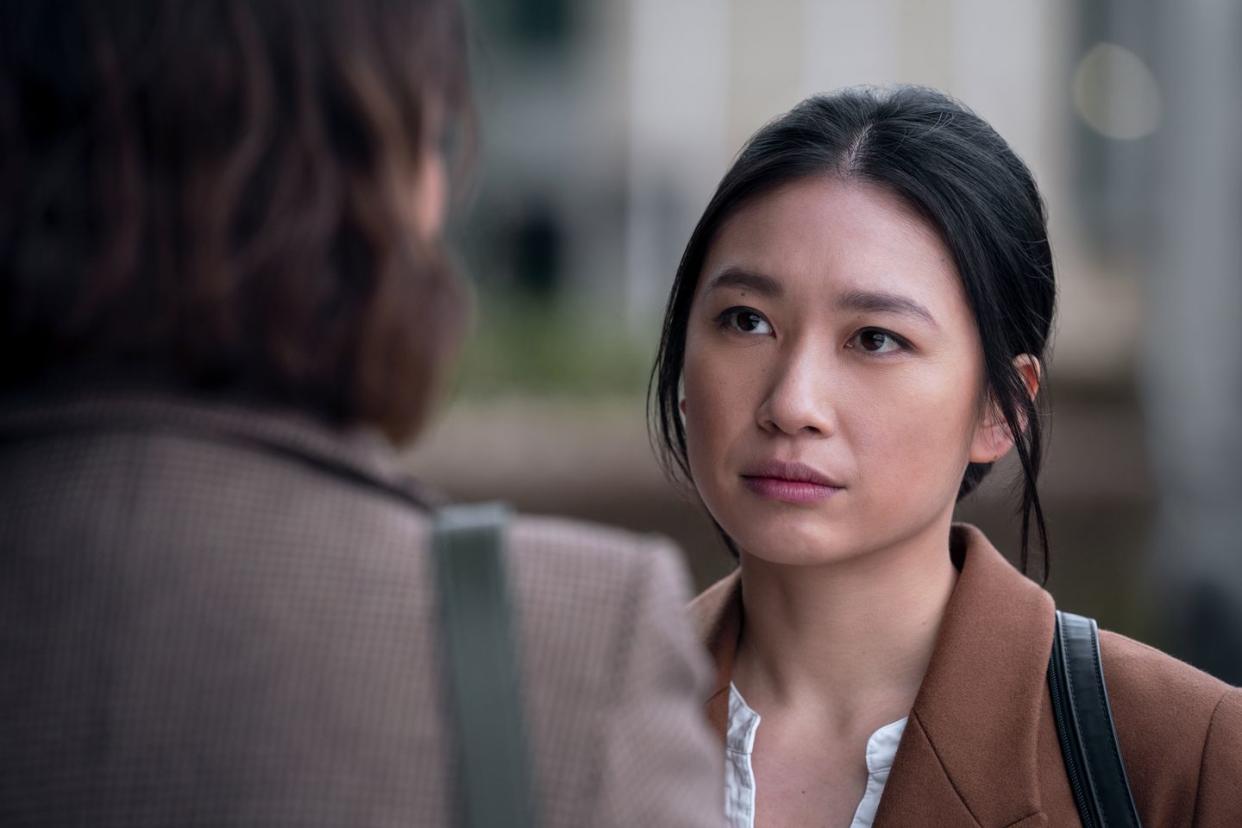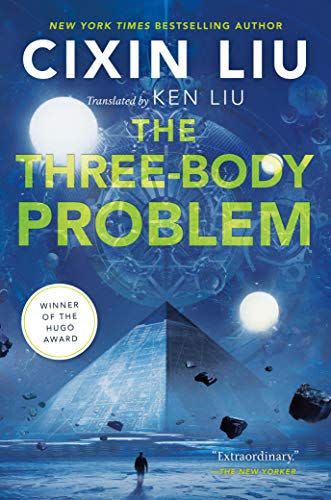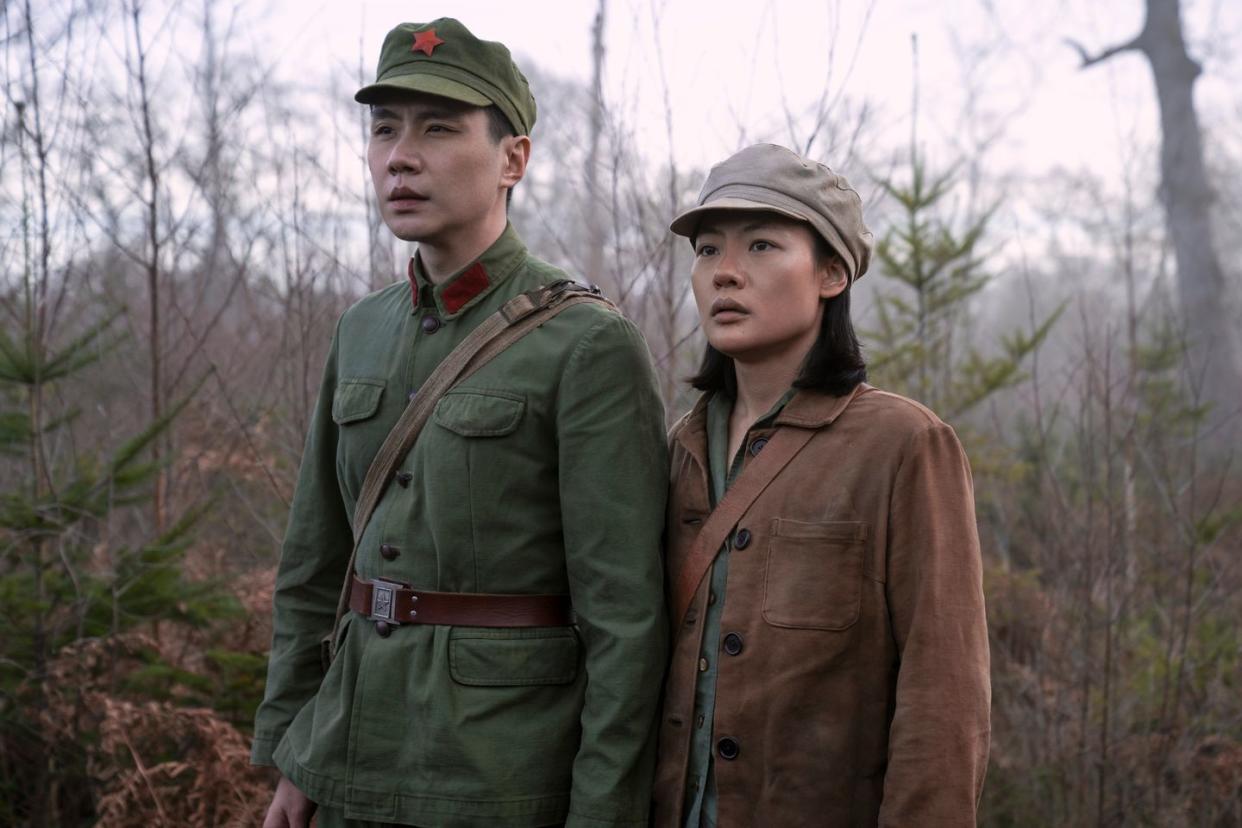The Seven Biggest Ways ‘3 Body Problem’ Changes the Book

"Hearst Magazines and Yahoo may earn commission or revenue on some items through these links."
This story contains spoilers for 3 Body Problem.
You might’ve heard that there’s an epic new sci-fi series from Game of Thrones showrunners David Benioff and D. B. Weiss, and that show is 3 Body Problem. Cocreated with Alexander Woo, the new, eight-episode Netflix series adapts Liu Cixin’s mega-popular, award-winning novels and turns aspects from all three books in his trilogy (The Three-Body Problem, The Dark Forest, and Death’s End) into a prestige drama that unfolds like a puzzle in the stars. Well loved by science buffs and President Obama alike, The Three-Body Problem has become a bellwether for sci-fi books that are both accessible and deeply concerned with actual physics.
Featuring an alien invasion that will take four hundred years to arrive and a future history that spans centuries, 3 Body Problem has a larger scope than that of literally any sci-fi TV show, ever. That said, season 1—which premieres today—sticks mostly to the twentieth and twenty-first centuries. Is this a faithful adaptation of the novels? Yes and no. Mostly, the show knocks out the first book, digs into the beginnings of the second, and even finds a way to reference the third. Confused? Don’t be. Here’s your super-easy guide to how 3 Body Problem on Netflix alters the dense and contemplative books.
One Book Character Is Split Into Three
In the original novel—during the present-day sections—the primary point-of-view character is Wang Miao, a nanotech expert who is embroiled in the machinations of the gradual alien invasion. Wang is the first person we see encounter the trippy “3 Body” virtual-reality game, which teases the Trisolarian star system’s true structure. But not every reader thinks the character is super memorable. Since the book’s 2008 publication in China, some Chinese fans have considered him to be such a thin character—and existing in the book only to experience the plot—that various memes have cropped up. (See: jokes like “Who’s Wang?” and “Where’s Wang?”) Novelist Liu even downgraded Wang for the second book, The Dark Forest, essentially replacing him with the more dynamic and controversial science guy Luo Ji. So it seems as if the Netflix adaptation overcorrects the Wang problem by splitting him into three bodies: Auggie Salazar (Eiza González), Jack Rooney (John Bradley), and Jin Cheng (Jess Hong).
Auggie takes over the duties as the nanotech researcher, making her the closer one-for-one analog for Wang Miao. Even though her backstory is entirely different, it’s Auggie’s nanotech fibers (like Wang’s in the book) that take out the huge ship Judgment Day. However, unlike Wang, Auggie doesn’t find herself drawn into the “3 Body” virtual experience. Instead, on the show, Jack and Jin both get VR helmets and participate in the game, which eventually draws them close to the conspiracy involving humans who are assisting the aliens in the long-term invasion of Earth. While snack mogul Jack doesn’t really have a direct analog in the book, he does glean a few things about the 3 Body game that Wang learned in the book, making his and Jin’s comprehension of the game a shared experience. In the original text, it was Wang working through it on his own. Because Jack is killed by Tatiana (Marlo Kelly, and not a book character at all), Jin finds herself at the secret meeting of humans who sympathize with the San-Ti.

Jin’s and Will’s Stories Jump Ahead to the Third Book
By the end of the series, Jin switches from a partial Wang Miao analog to a closer match of Cheng Xin, a character from the third book, Death’s End. In that novel, Xin (Jin on the show) asks Yun Tianming to put his brain into a probe to help with the Staircase Project. On the series, Yun Tianming has become Will Downing (Alex Sharp), who, along with the other core group of contemporary characters, knows everyone from college. As in Death’s End, Will buys Jin a star through the “Stars Our Destination Project.” So because the final episode concludes with Will’s brain probe not staying on its correct trajectory, season 1 ends partly where the third novel begins.
Book 2’s and Book 3’s Timelines Match Up, Mostly
Until episode 5, 3 Body Problem sticks to the events of the first novel, The Three-Body Problem. However, after episode 5 (“Judgment Day”) and starting with episode 6 (“The Stars Our Destination”), the series begins to adapt events from The Dark Forest and Death’s End. While the two novels are largely known for the fact that these events jump much further ahead into the future, both of them begin with situations that are more or less contemporaneous with those in the first book.
In fact, before the Netflix series even unfolds, 3 Body Problem borrows from elements of the beginning of Death’s End. Although we don’t know it at first, Verra has learned that her mother, Ye Wenjie, is the first human to contact the San-Ti, which caused the aliens to send a fleet of ships to Earth. So when Verra commits suicide at the start of the show, she’s a stand-in for Yang Dong, Ye Wenjie’s daughter in the books. To be clear, Yang Dong commits suicide at the start of the first book, too—it’s just that the third book revisits these events from her point of view, whereas the first one doesn’t. In depicting Verra’s suicide in episode 1, 3 Body adapts The Three-Body Problem and Death’s End simultaneously.

The Three-Body Problem
amazon.com
$10.59
Evans, Judgment Day, and Verra
Speaking of Verra (Yang Dong in the book), on the series we learn that she’s the daughter of Ye Wenjie and Mike Evans. In the book, the two do team up in both the past and the present, but they do not have a child together; Yang Dong is the daughter of Ye Wenjie and Yang Weining. Ye Wenjie kills both Yang Weining and Lei Zhicheng, her coworkers at Red Coast Base. She does this partly to cover for the fact that she sent the signal to the aliens.
But on the series, Mike Evans—in the past and the present—is the secret father of Verra, and his life on Judgment Day is depicted in much more detail than in the first novel. 3 Body Problem reveals that the entire cult of San-Ti worshippers includes families and children. This makes the destruction of the ship much grislier on the show than on the page. In this version, innocent children are literally killed by the “good guys,” which is an invention of Woo, Benioff, and Weiss. In another entry in the horrible-things-happening-to-children department, the show turns the in-game virtual character “Follower” into a child, who is supposed to represent Verra when she was a kid. In the first novel, Follower wasn’t a child—and in the book was never supposed to be a digital version of Yang Dong.
The San-Ti and the Sophons
In the book trilogy (collectively known in English as Remembrance of Earth’s Past), the invading aliens are always referred to as the Trisolarians. This is because their star system has three suns, hence “tri-solar.” However, the Netflix show changes this to the San-Ti, which we’re told is Chinese for “three-bodied person”; in real life, “San-Ti” references a 2022–23 anime adaptation of The Dark Forest.
In both versions, we learn that the San-Ti (aka Trisolarians) send complex computers via protons called Sophons. These higher-dimension thingamabobs allow the aliens to control and manipulate what people literally see every single day of their lives. Also, in both the impact of the Sophons is essentially the same: Humanity is constantly spied on, and scientific results are unreliable thanks to Sophon data manipulation. The biggest difference is that on the show the San-Ti have a kind of Sophon representative in the form of a woman who wears a sword on her back. Played by Sea Shimooka, this Sophon FaceTimes (for lack of a better term!) with the characters in a way that doesn’t happen in the books.

Ye Wenjie’s fate
Without a doubt, the most book-accurate aspects of 3 Body Problem involve Ye Wenjie. In 1960s-set sections, where young Ye Wenjie is played by Zine Tseng, we get nearly verbatim book-specific moments. Even in the present, where Ye Wenjie is played by sci-fi legend Rosalind Chao, the ethos of this all-important book character comes across like gangbusters.
Yet the show takes a big swing by changing the end of Ye Wenjie’s story. In the first novel, in the very last chapter (“The Ruins”), she returns to Red Coast Base and muses on the “sunset for humanity.” On the series, at the end of episode 7, she is met at the ruins of Red Coast Base by the San-Ti human agent Tatiana. Although their conversation is tender, it’s understood that Tatiana is there to kill Ye Wenjie—or, at the very least, ensure that she jumps off the mountain. Tatiana doesn’t exist in the novels and the books are far more subtle about how Ye Wenjie dies.
Saul the Wallfacer
In the season 1 finale, “Wallfacer,” Saul Durand (Jovan Adepo) becomes a human Wallfacer—a strategist who is granted multinational powers to fight the San-Ti entirely in their mind. Because the San-Ti don’t understand lying and aren’t telepathic, the biggest advantage humans have is to plan secretly. On the show, Saul is one of three Wallfacers, but in The Dark Forest, there are five.
Although it’s not clear at the start, by the end of season 1, Saul morphs into a fairly close analog for the book character Luo Ji. First introduced in The Dark Forest, Luo Ji becomes perhaps the most dynamic character of the entire series. In two books, he goes from cynical, promiscuous academic to determined savior of humankind and Trisolaris. The series does a decent job of re-creating Luo Ji’s/Saul’s recruitment into the Wallfacer project, even reenacting a moment from The Dark Forest in which an innocent woman who had a one-night stand with Saul is killed in a car accident that isn’t actually an accident.
For the most part, the character of Saul is really only similar to Luo Ji in plot purpose and circumstance. Because Auggie doesn’t exist in the trilogy, Saul and Auggie’s on-again-off-again romance was invented for the series. In the books, Luo Ji dates a novelist and becomes obsessed with the idea of creating an utterly perfect fictional lover, which is something he bizarrely makes true with his unilateral Wallfacer powers.
In the end, Saul, Jin, Auggie, and Will are put on paths that are similar to those of their book counterparts. Because the show has turned them into totally new characters, however, their lives seem very much in motion and their ultimate destinies are unpredictable—even by the most complex space-alien computer.
You Might Also Like
